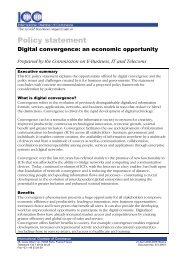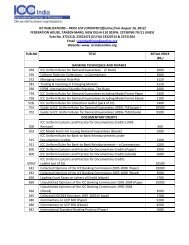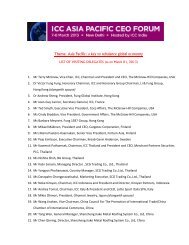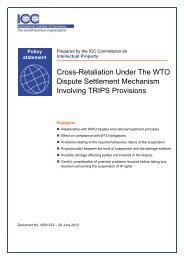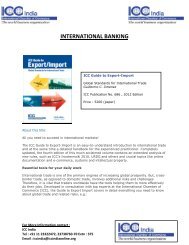2013 - ICC India
2013 - ICC India
2013 - ICC India
- No tags were found...
Create successful ePaper yourself
Turn your PDF publications into a flip-book with our unique Google optimized e-Paper software.
22<strong>ICC</strong> BANKING COMMISSION | <strong>2013</strong> GLOBAL RISKS TRADE FINANCE | ANALYSIS OF SHORT-TERM PRODUCTS3.3. LOW CONVERSION RATEAs noted above in the individual product descriptions, L/Cs (both import andexport) and performance guarantees are dependent on an event happeningbefore the bank needs to make a payment to the beneficiary of the product.Not only must the underlying service or transaction happen (which is notalways the case) but, in general, documentation needs to be approved bythe bank as being compliant. In the case of performance guarantees, theresulting service must be considered to have fallen short of agreed terms 22 .Only once this has happened does the issuing bank need to make a payment.Once these contingent events have happened and the contingent liability hasconverted into an exposure, the issuing bank will typically use funds directlyfrom the importers’ accounts to make the payment. This means the issuingbank typically only pays out of its own funds where there are insufficientfunds in the importers’ accounts to meet the claim.The Trade Register provides two alternate measures of the extent to whichproducts do or do not convert: (i) the number of document sets rejectedon first presentation; and (ii) the number of transactions that expire withoutpayment. These figures do not provide an ideal measure of the proportionof transactions that never result in an exposure for the bank 23 , but they doprovide a potential range for the likely conversion rate on these products.Figure 16 provides an overview on both expiries and rejections.FIGURE 16Observed % of expiries and rejections for off balancesheet products, 2008-11EXPIRIESDOCUMENT REJECTIONSTOTAL 2008-11# TRANS-ACTIONS#EXPIRIES%EXPIRIES# TRANS-#%ACTIONS REJECTIONS REJECTIONSImport L/Cs 640,192 128,012 20% 901,394 930,226 103% 24Export Confirmed L/Cs 65,264 18,970 29% 142,256 76,630 54%Perf. Guarantees 111,599 93,355 84% 54,635 9 0%Total 817,055 240,337 29% 1,098,285 1,006,865 92%As the table illustrates, expiries are highly common on guarantee products,especially for performance guarantees where approximately 85% expirewithout bank payment (i.e. a claim is only made on around 10% ofguarantees). This is understandable and this kind of product is being usedto protect against the unexpected lack of performance of the counterparty.We also observe higher levels of expiries for export confirmed L/Cs thanimport L/Cs. This is probably due to the insulation that the confirmingbank provides between the issuing bank and the corporate and its lowerlikelihood of default.From a risk measurement perspective, the treatment of cases that neverconvert to obligations is potentially a matter of “taste”. It could be arguedthat since these cases never become “on balance sheet” they should beused to reduce the exposure at default estimate on trade finance exposures.Alternatively, it could be argued that, in the case of a customer defaultand presentation of compliant documentation, the exposure is 100% of theamount of the contract. Therefore this low conversion rate does not reducethe “exposure” but rather reduces the likelihood of a default. At this stage wehave implicitly adopted the second approach but plan to explore this furtherwith banks and regulators, as well as refine the data captured for futurereports. However, what is clear is that this low conversion rate is likely to be acontributing factor to the low observed loss rate on trade finance products.



